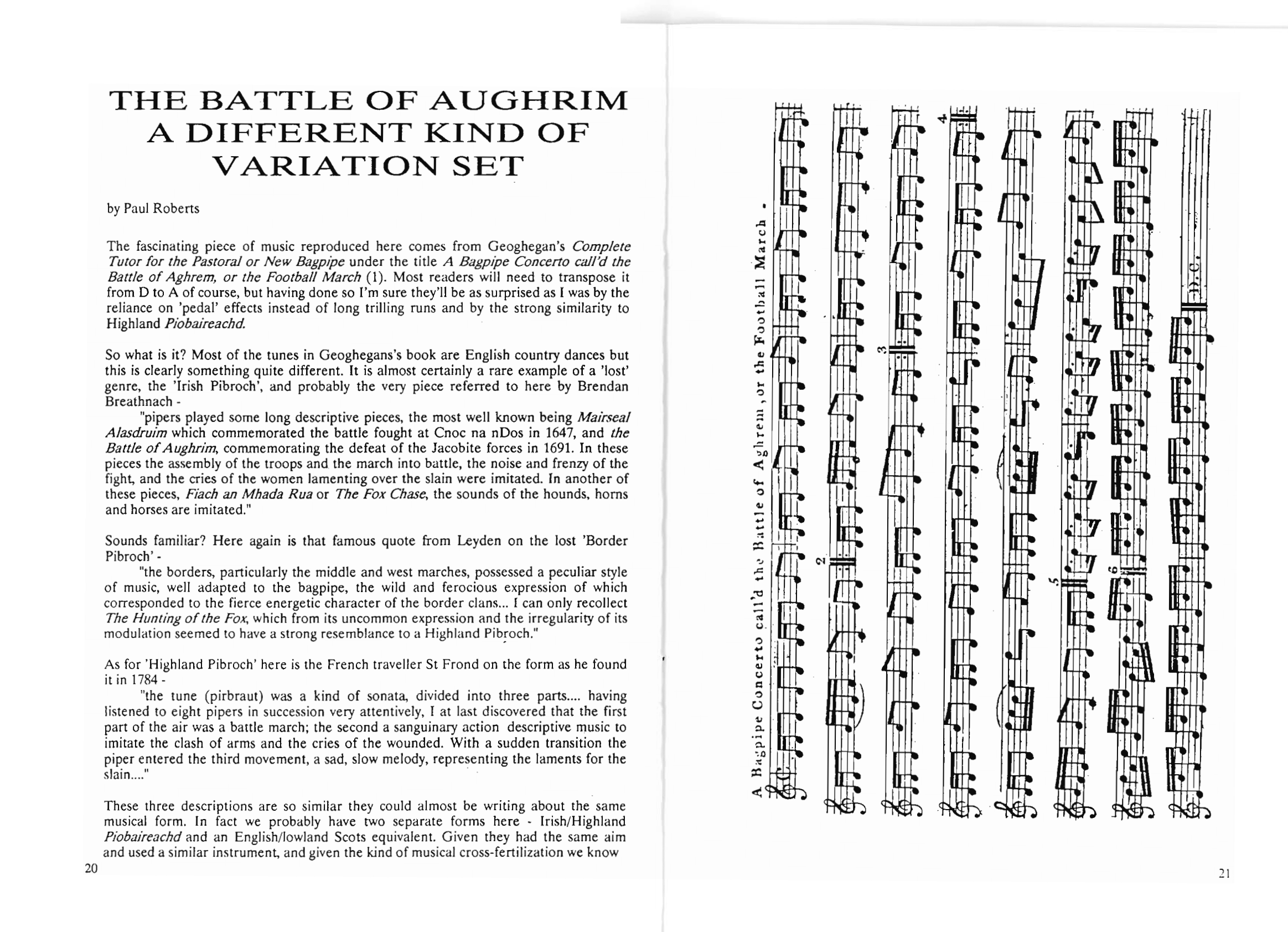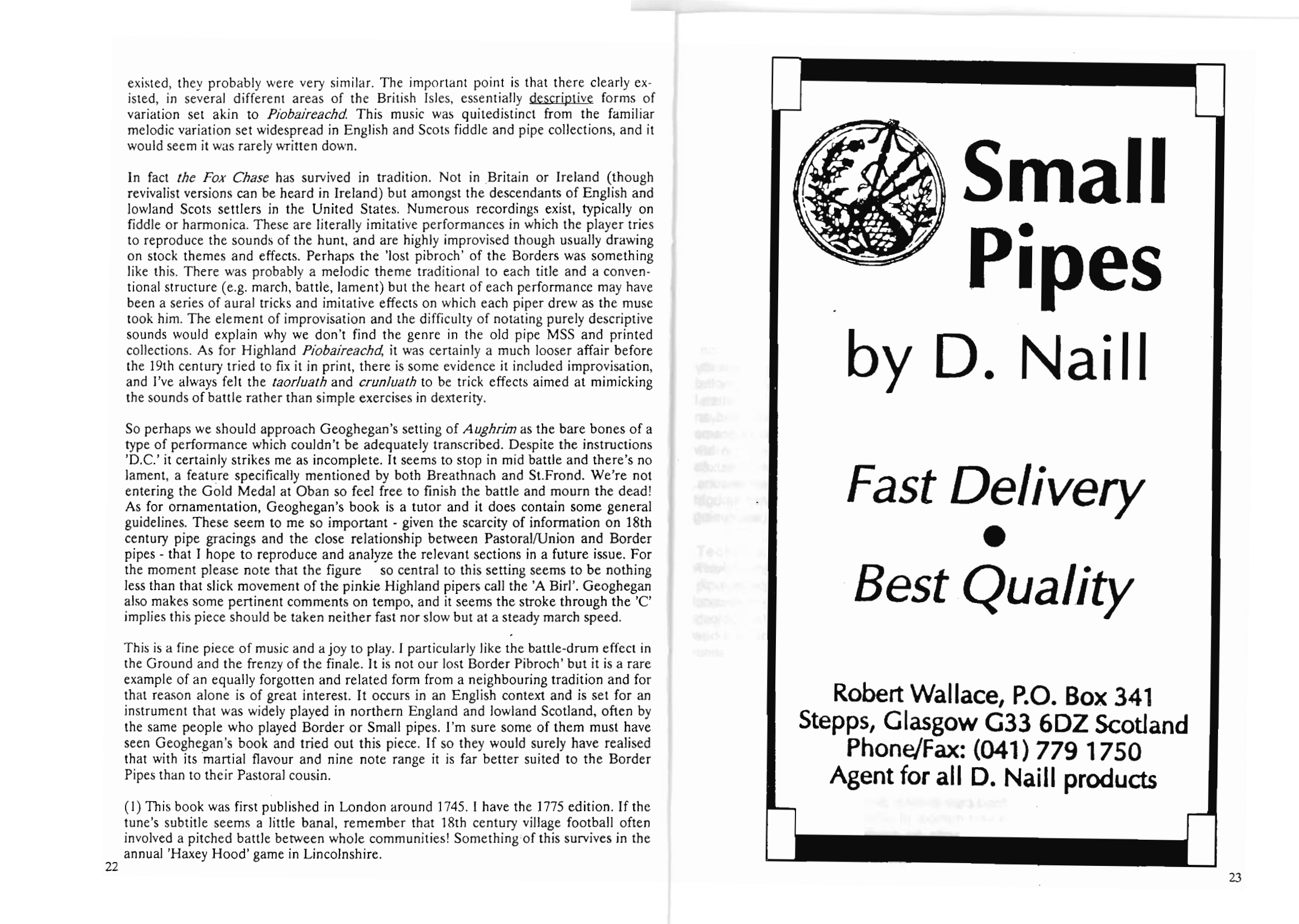The Battle of Aughrim - A Different Kind of Variation Set


A DIFFERENT KIND OF VARIATION SET by Paul Roberts
The fascinating piece of music reproduced here comes from Geoghegan’s Complete Tutor for the Pastoral or New Bagpipe under the title A Bagpipe Concerto call‘d the Battle of Aghrem, or the Football March (1). Most readers will need to transpose it from D to A of course, but having done so I’m sure they’ll be as surprised as I was by the reliance on
‘pedal’ effects instead of long trilling runs and by the strong similarity to Highland Piobaireachd. So what is it? Most of the tunes in Geoghegans’s book are English country dances but this is clearly something quite different. It is almost certainly a rare example of a
‘lost’ genre, the ‘Irish Pibroch’, and probably the very piece referred to here by Brendan Breathnach -
“pipers played some long descriptive pieces, the most well known being Marrseal Alasdruim which commemorated the battle fought at Cnoc na nDos in 1647, and the Battle of Aughrim, commemorating the defeat of the Jacobite forces in 1691. In these pieces the assembly of the troops and the march into battle, the noise and frenzy of the fight, and the cries of the women lamenting over the slain were imitated. In another of these pieces, Fiach an Mhada Rua or The Fox Chase, the sounds of the hounds, horns and horses are imitated.”
Sounds familiar? Here again is that famous quote from Leyden on the lost ‘Border Pibroch’ - “the borders, particularly the middle and west marches, possessed a peculiar style of music, well adapted to the bagpipe, the wild and ferocious expression of which corresponded to the fierce energetic character of the border clans... I can only recollect The Hunting of the Fox, which from its uncommon expression and the irregularity of its modulation seemed to have a strong resemblance to a Highland Pibroch.”
As for ‘Highland Pibroch’ here is the French traveller St Frond on the form as he found it in 1784 -
“the tune (pirbraut) was a kind of sonata, divided into three parts... having listened to eight pipers in succession very attentively, I at last discovered that the first part of the air was a battle march; the second a sanguinary action descriptive music to imitate the clash of arms and the cries of the wounded. With a sudden transition the piper entered the third movement, a sad, slow melody, representing the laments for the slain...”
These three descriptions are so similar they could almost be writing about the same musical form. In fact we probably have two separate forms here - Irish/Highland Piobaireachd and an English/lowland Scots equivalent. Given they had the same aim and used a similar instrument, and given the kind of musical cross-fertilization we know existed, they probably were very similar. The important point is that there clearly existed, in several different areas of the British Isles, essentially descriptive forms of variation set akin to Piobaireachd. This music was quite distinct from the familiar melodic variation set widespread in English and Scots fiddle and pipe collections, and it would seem it was rarely written down.
In fact the Fox Chase has survived in tradition. Not in Britain or Ireland (though revivalist versions can be heard in Ireland) but amongst the descendants of English and lowland Scots settlers in the United States. Numerous recordings exist, typically on fiddle or harmonica. These are literally imitative performances in which the player tries to reproduce the sounds of the hunt, and are highly improvised though usually drawing on stock themes and effects. Perhaps the ‘lost pibroch’ of the Borders was something like this. There was probably a melodic theme traditional to each title and a conventional structure (e.g. march, battle, lament) but the heart of each performance may have been a series of aural tricks and imitative effects on which each piper drew as the muse took him. The element of improvisation and the difficulty of notating purely descriptive sounds would explain why we don’t find the genre in the old pipe MSS and printed collections. As for Highland Piobaireachd, it was certainly a much looser affair before the 19th century tried to fix it in print, there is some evidence it included improvisation, and I’ve always felt the taorluath and crunluath to be effects aimed at mimicking the sounds of battle rather than simple exercises in dexterity.
So perhaps we should approach Geoghegan’s setting of Aughrim as the bare bones of a type of performance which couldn’t be adequately transcribed. Despite the instructions ‘D.C.’ it certainly strikes me as incomplete. It seems to stop in mid battle and there’s no lament, a feature specifically mentioned by both Breathnach and St. Frond. We’re not entering the Gold Medal at Oban so feel free to finish the battle and mourn the dead! As for ornamentation, Geoghegan’s book is a tutor and it does contain some general guidelines. These seem to me so important - given the scarcity of information on 18th century pipe gracings and the close relationship between Pastoral/Union and Border pipes - that I hope to reproduce and analyze the relevant sections in a future issue. For the moment please note that the figure so central to this setting seems to be nothing less than that slick movement of the pinkie Highland pipers call the ‘A Birl’. Geoghegan also makes some pertinent comments on tempo, and it seems the stroke through the ‘C’ implies this piece should be taken neither fast nor slow but at a steady march speed.
This is a fine piece of music and a joy to play. I particularly like the battle-drum effect in the Ground and the frenzy of the finale. It is not our ‘lost Border Pibroch’ but it is a rare example of an equally forgotten and related form from a neighbouring tradition and for that reason alone is of great interest. It occurs in an English context and is set for an instrument that was widely played in northern England and lowland Scotland, often by the same people who played Border or Small pipes. I’m sure some of them must have seen Geoghegan’s book and tried out this piece. If so they would surely have realised that with its martial flavour and nine note range it is far better suited to the Border Pipes than to their Pastoral cousin.
(1) This book was first published in London around 1745. I have the 1775 edition. If the tune’s subtitle seems a little banal, remember that 18th century village football often involved a pitched battle between whole communities! Something of this survives in the annual ‘Haxey Hood’ game in Lincolnshire.
